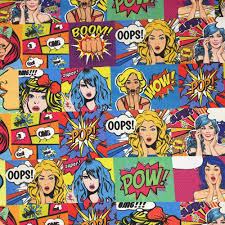The Captivating World of Comic Art
Comic art is a vibrant and dynamic medium that has captured the hearts and imaginations of people around the world for decades. From colourful superheroes to poignant graphic memoirs, comic art encompasses a wide range of styles and genres, making it a versatile and engaging form of storytelling.
One of the unique aspects of comic art is its ability to combine visual elements with narrative storytelling. Through a series of panels, speech bubbles, and illustrations, comic artists can create immersive worlds and compelling characters that draw readers into their stories.
Comic art is not limited by boundaries or constraints – it can be used to explore complex themes, convey emotions, and provoke thought in ways that transcend traditional forms of literature. Whether through humour, drama, action, or fantasy, comic art has the power to resonate with readers on a personal level.
Over the years, comic art has evolved and diversified, giving rise to new voices and perspectives in the industry. Independent creators have found success through webcomics and self-published works, while established publishers continue to produce iconic series that captivate audiences of all ages.
From classic newspaper strips to graphic novels tackling social issues, comic art continues to push boundaries and challenge conventions. It serves as a platform for artists to experiment with visual storytelling techniques, pushing the medium forward into exciting new territory.
Whether you’re a seasoned comic enthusiast or new to the world of sequential art, there’s something for everyone to enjoy in the captivating world of comic art. So grab a comic book, immerse yourself in its pages, and let your imagination take flight as you explore the endless possibilities that this unique medium has to offer.
Five Essential Tips for Enhancing Your Comic Artistry: Storytelling, Style, and Skill Development
- Focus on storytelling through your artwork to engage readers.
- Experiment with different styles and techniques to find your unique artistic voice.
- Study anatomy and perspective to create more dynamic and realistic characters and scenes.
- Use colour theory to evoke emotions and set the tone for your comic.
- Seek feedback from other artists or comic enthusiasts to improve and grow as an artist.
Focus on storytelling through your artwork to engage readers.
To truly captivate readers through comic art, it is essential to focus on storytelling through your artwork. Every panel, every character expression, and every background detail should serve the narrative, drawing readers into the story and immersing them in the world you have created. By prioritising storytelling in your artwork, you can create a powerful connection with your audience, evoking emotions, building suspense, and delivering a memorable reading experience that resonates long after the final page is turned.
Experiment with different styles and techniques to find your unique artistic voice.
To truly unlock your creative potential in comic art, it’s essential to experiment with a variety of styles and techniques. By exploring different approaches to visual storytelling, you can uncover your own unique artistic voice that sets you apart from others in the field. Embrace the freedom to mix and match styles, play with various tools and mediums, and push the boundaries of traditional conventions. Through this process of experimentation and discovery, you’ll not only hone your skills but also develop a distinct artistic identity that resonates with your audience and allows your creativity to flourish.
Study anatomy and perspective to create more dynamic and realistic characters and scenes.
To enhance the depth and realism of your comic art, it is essential to dedicate time to studying anatomy and perspective. By mastering these fundamental principles, you can imbue your characters and scenes with a sense of dynamism and authenticity. Understanding human anatomy allows you to depict figures with more accuracy and detail, while knowledge of perspective enables you to create immersive environments that draw viewers into your narrative. Investing in learning these foundational skills will undoubtedly elevate the quality of your artwork, making your characters more lifelike and your scenes more visually compelling.
Use colour theory to evoke emotions and set the tone for your comic.
In the realm of comic art, harnessing the principles of colour theory can be a powerful tool to evoke emotions and establish the tone of your narrative. By strategically selecting hues, shades, and contrasts, comic artists can create visual atmospheres that resonate with readers on a subconscious level. Warm tones like reds and oranges may convey passion or intensity, while cool blues and greens can evoke calmness or melancholy. The careful application of colour not only enhances the aesthetic appeal of a comic but also adds depth and nuance to the storytelling experience, influencing how audiences interpret and connect with the narrative unfolding before them.
Seek feedback from other artists or comic enthusiasts to improve and grow as an artist.
Seeking feedback from other artists or comic enthusiasts is a valuable tip for aspiring comic artists looking to improve and grow in their craft. Constructive criticism and insights from fellow creators can offer fresh perspectives, highlight areas for improvement, and inspire new ideas. By engaging with a community of like-minded individuals, artists can gain valuable feedback that helps them refine their skills, develop their unique style, and ultimately evolve as artists. Embracing feedback not only fosters growth but also nurtures a sense of camaraderie and collaboration within the vibrant world of comic art.


Leave a Reply